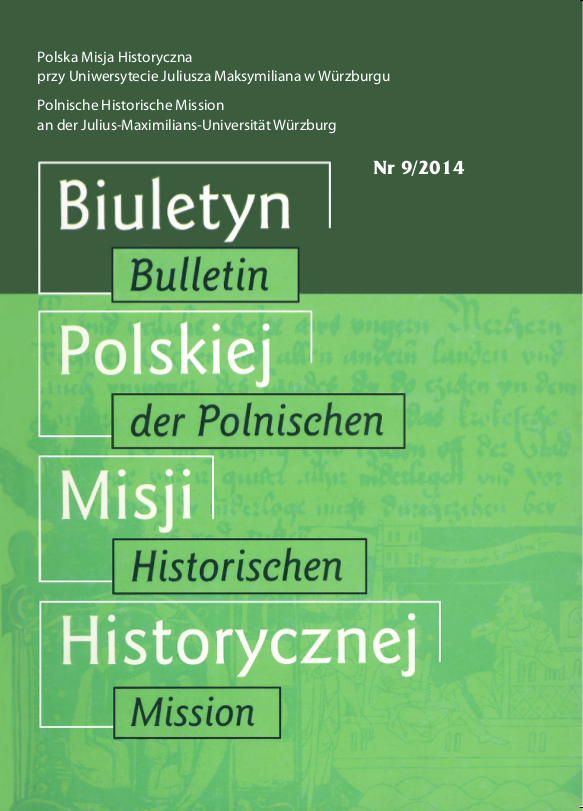The History of the Synagogue in Tarnogród as an Example of the Development of the Jewish Community in the 18th Century on Polish Lands
DOI:
https://doi.org/10.12775/BPMH.2014.003Keywords
Synagogue, the Jewish community, Baroque, TarnogródAbstract
The synagogue in Tarnogród still exists but has changed its nature and its function. It does attest the extraordinary position the Jewish community had achieved in this city. The history of the Jewish community and the synagogue started in the mid-sixteenth century with the privilege of Stefan Batory. Th e history of the Jewish community in this town is an example of the relationship between the ruling authorities, but also between the non-Jewish inhabitants of Tarnogród and the Jews. The state of the Jews was mainly determined by the privileges which this group received at that time. The Tarnogród synagogue is an example of how economics and social relations shaped the image of a small town. This is reflected in the constant modernization of the building due to the growth of the Jewish community. The synagogue was originally made of wood, repeatedly destroyed and once burned down, at the end of the seventeenth century it was given the form of a brick building. The functionality of the synagogue referred to the architectural patterns that prevailed at that time. The history of the synagogue in Tarnogród and its form can be perceived as a proper example of the formation and the development of the Jewish community in Eastern Poland.
References
Źródła archiwalne / Archivalische Quellen / Archival Sources
Archiwum Wojewódzkiego Urzędu Ochrony Zabytków w Lublinie, Delegatura w Zamościu
– Sign. N0247, E. Lorenz, Dokumentacja konserwatorska zabytków. Synagoga Tarnogród, (1986).
– Sign. N0452, M. Niedzielska, Bożnica w Tarnogrodzie. Dokumentacja naukowo-historyczna, (1980).
Literatura / Literatur / Literature
Bałaban M., Bożnice obronne na wschodnich kresach Rzeczypospolitej, in: ders., Studja Historyczne, (1927), S. 93 – 99.
Bałaban M., Zabytki historyczne Żydów w Polsce, (Pisma Instytutu Nauk Judaistycznych w Warszawie 1, 1929).
Baliński M., Lipiński T., Starożytna Polska pod względem historycznym, jeograficznym i statystycznym, 2 (1886).
Bergman E., Jagielski J., Zachowane synagogi i domy modlitwy w Polsce. Katalog, (1996).
Cohen A., Talmud, (2002).
Depczyński W., Tarnogród 1567–1967. Monografia historyczno-gospodarcza, (1970).
Greenwald Z., Bramy Halachy. Religijne prawo żydowskie, (2005).
Piechotka K. und M., Bóżnice drewniane, (1957).
Piechotka K. und M., Bramy Nieba. Bóżnice murowane na ziemiach dawnej Rzeczypospolitej,
(1999).
Słownik geograficzny Królestwa Polskiego i innych krajów słowiańskich, hg. v. B. Chlebowski, 12 (1892), S. 186–187.
Tarnawski A., Działalność gospodarcza Jana Zamoyskiego, kanclerza i hetmana W. Kor. 1572–1605, (Badania z Dziejów Społecznych i Gospodarczych 18, 1935).
Tomaszewski J., Żydzi w Polsce. Dzieje i kultura. Leksykon, (2001).
Trzciński A., Śladami zabytków kultury żydowskiej na Lubelszczyźnie, (1990).
Zajczyk S., Architektura barokowych bożnic murowanych w Polsce (zagadnienia i systematyka materjału zabytkowego), „Biuletyn Historji Sztuki i Kultury. Kwartalnik wydawany przez Zakład Architektury Polskiej i Historji Sztuki Politechniki Warszawskiej“, 1, 4 (1932/1933), S. XXX–XXXII, 186–195.
Downloads
The publisher's shop:
Published
How to Cite
Issue
Section
License
The author submitting the text for publication is obliged to disclose all authors involved in the preparation of the text and (if applicable) an indication of the sources of financing of the publication, the contribution of scientific research institutions, associations and other entities ("financial disclosure").
In the case of texts prepared by two or more Authors, the Authors are obliged to send to the Editorial Staff a statement about the contribution of individual Authors to the publication (including their affiliation and an indication of the Author / Authors of the concepts, assumptions, methods, etc.). The main responsibility for the text lies with the author submitting it to the Editorial Board.
Please be advised that the editors of the Bulletin of the Polish Historical Mission are using the iThenticate anti-plagiarism program, since 2016 each article has been checked for authenticity. The editors declare that detected cases of scientific misconduct will be documented and made public by notifying relevant entities (institutions employing Authors, scientific institutions and associations, etc.).
Authors / Authors are asked to send the following documents to the Editor:
- declaration of the Author or Authors,
- statement of the Author or Authors,
- basic information about the article.
Universität Würzburg
Polnische Historische Mission
Philosophiegebäude
Am Hubland
97074 Würzburg, Germany
Stats
Number of views and downloads: 513
Number of citations: 0



